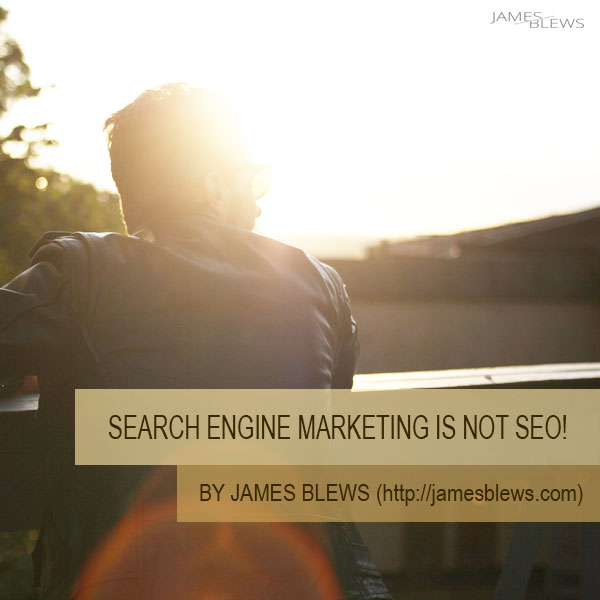I’m sure you, as a business owner, have found your inbox, as well as your voice-mail, containing a marketer or two, boasting services like SEO, search engine optimization and website optimization. I’m sure you have read, countless times, the same pitches about each of these companies giving you guaranteed rankings, explosive traffic and more. However…things aren’t always what they seem.
The truth is this, and it’s simple and dead-on…
SEO and search engine marketing are two completely different beasts.
Search engine optimization and search engine marketing are two completely different parts of online marketing. SEO is used as an umbrella and blanketed terms for all things dealing with search engines seeing your site and people clicking your site. But it’s not, and that SEO myth keeps right on going.
Just remember, SEM is the wider discipline that incorporates SEO. They will share similarities, but also hold differences over each other.
Today, we’ll look at SEO as well as search engine optimization marketing. We will see their differences and similarities. And, in the end, you will have a working knowledge about what an SEO professional can do for you, as opposed to a search engine marketing consultant.
Basic SEO and Search Engine Optimization Marketing Defined
To start this journey, I’m going to define the basics for both of these digital marketing methods.
I’m going to give you an example to first keep in mind.
SEO is the builder, and SEM is the painter.
You might not necessarily understand this fully, but you will in a few minutes…so hang in there with me.
SEO defined
SEO, otherwise known as search engine optimization, is the process of using standard practices and guidelines to format and supply information on a website for search engines. These methods can use content structure, formatting (via HTML, as in meta tags, formatting tags, etc), as well as internal linking and sitemap creation.
Also, SEO is not exclusively for the content seen on a website.
Defining search engine optimization marketing
Search engine optimization marketing, sometimes called search engine marketing or SEM. Search engine marketing, to contrast SEO, involves building organic search traffic into a website from search engines like Google or Bing. These methods might include link building, content creation and marketing and building online presence and web visibility.
Search engine marketing really involves the mix of onsite and offsite practices to increase organic search traffic.
SEO and search engine marketing differences
As you can see, there are similarities between SEO and search engine marketing…and equal amounts of differences. The issue with SEO, at its core, is that most business, yours possibly included, comes from organic search traffic – more people coming into your site for sales. However, SEO is actually more about internal structure, rather than what you might actually need.
SEO is structure, SEM is content
SEO, in this pairing, is the structure, the building, the analyst. Content does not matter as much as how it is presented. In fact, content does not matter at all when it comes to SEO; only that certain metas tags, the URL and structure is contextual correct within the page and site.
The following are the areas in which search engine optimization is performed.
- Title and Title Tag
- Link Naming/Permalink
- Description Meta Tag
- H1 Tag present (one and only one per page)
- Canonical Tag
- Sitemaps (content, pages, images and video)
- Internal errors and link issues

For search engine marketing, however, we aren’t considering the structure and “how”, but instead the “what”. You will also want to focus on where inbound links are from, as well as what the anchor text is for those links.
- Keyword Themes and Groups
- User intent
- Use contextual relevance
- Subject matter
- Anchor text subject matter
- Brand mentions and links
Earlier, I gave you a line to help define the difference between SEO and SEM. Remember it?
SEO is the builder, and SEM is the painter.
That sentence is a lot clearer now, I hope. Maybe not? Then let’s look at more differences.
Traffic Generation from marketing, Usability comes from structure
Search engine marketing is about…marketing. Internet marketing, just like advertising, is a method of looking at how and where that traffic can be created into your website. For this discussion, we will be talking about organic search traffic from Google, Bing and other search engines.
With that said, we can also generate traffic and strengthen our core inbound traffic and search engine rankings, but using social media marketing, outreach and content marketing, video marketing and more.
SEO, conversely, deals with how structured the site is for users to use. And that is what usability is. To really understand this, think about the websites you go to. Have you ever questioned why a navigation bar is difficult to use? Have you ever questioned why the website is difficult to use while clicking links or going from page to page?
Items like these, as well as page-load speed, click sizes for mobile users, mobile-friendly/responsive and more. These are all parts of the website that, after you enter it, keeps you there. These items makes the website easy to use, easy to navigate and makes it a place you want to come back to.
External versus internal issues
Search engine optimization marketing uses methods to drive traffic from organic search into your site, as mentioned before. This can be a very external set of actions, including, link building, outreach and even brand mentions and content inclusions.
SEM also deals with the content delivered and housed on the site as well. When composed correctly, and marketed well, will drive inbound traffic to your website over and over based on other linking to it, as well as talking about it on social media, forums, blog comments and other linking methods.
SEO, as opposed to SEM, is a very internal method of optimization. SEO deals with making your site as optimized as possible allowing search to produce real results in their SERPs.
Search engine marketing and SEO can work together
Not everything SEM and SEO are separate and different. After all, both deal with search engines, both deal with increasing your site’s visibility and traffic on and from search engines as well.
Your brand awareness on various platforms
Google, over a period of time, has gone from mentioning that branding is key to local and national influencing rankings, to branding and branding and brand awareness becoming a solid set-in-stone influencer in rankings.
However, what we are talking about now is brand awareness along with brand message. Remember that your brand is about your industry, your region, you and your employees. Your brand is not a keyword. However, your brand can correlate to an industry, a keyword group, a conversation, etc., and you can be rewarded for that.
For this, I always recommend using content with your brand message, and then repurpose your content and include this with your message everywhere that is relevant. Think social media, social sharing and social mentions here as well. Here is a great post from Bill Slawski covering a patent from Google concerning brands, entities and Google, their social power and ranking factor.

A big no-no that Google has stated, over and over again, is that your brand/website shouldn’t be linked to, exclusively, by a keyword. Instead, anchor text being linked to, over and over by a brand, builds brand strength.
And so, onpage SEO and your brand message, will need to match content as well as inbound links for your website.
Melding content with context, here, there and everywhere
As eluded to above, brand message can be created with content and context. But how can we make that bridge between platforms like our website and social media, search engines or other platforms seamless?
For social media platforms, the answer is in preview images presented as well as the descriptions given on link sharing.
These link share images are those preview images you see on Facebook, Twitter, Google+ and other social media platforms whenever someone shares a link. While very few platforms decipher the title, description, link, images, etc., most major platforms allow you to use meta tags on your site to handle this. In a way, you help them out by providing a clear message as to the link’s content, and you are helped out by being more visible in user’s feeds.
Now, we are taking onpage content, and using SEO in the form of formatted meta tags, to make the information more digestible and linkable, on social media platforms. You make the marketing easier to use for your clients, customers and website visitors.
For more information, you can read on Facebook OpenGraph and Twitter Cards.
What you need to know about SEO and SEM
I hope things are now clearer concerning SEO, its value and what search engine marketing is. Both have different areas that can strengthen your brand and your website. And, many times, these can overlap and produce quality, long-lasting results.




